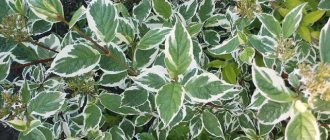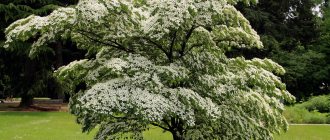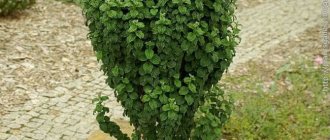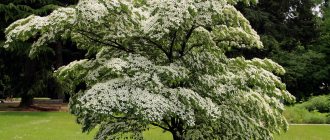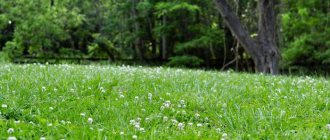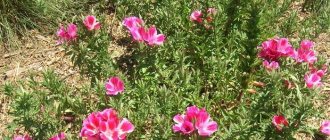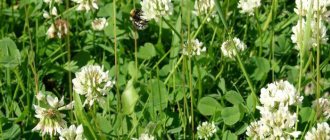Flower growers can choose white derain to decorate their gardens and hedges. The shrub is absolutely unpretentious and undemanding to care, grows quickly and creates a decorative and pleasing picture to the eye. These properties are preserved at any time of the year: in spring it blooms magnificently, in summer and autumn it is decorated with white, blue-tinged berries and spectacular foliage, and in winter it flaunts bright cherry branches against a snowy background.
The expressiveness of the bush is due to the correctly chosen location and variety, of which there are many in turf. Of course, plant care and careful shaping play a big role.
Description of the white Derain variety “Sibirika”
Cornus alba 'Sibirica' is a very hardy deciduous shrub with oval green leaves. The homeland of the species is Siberia, which is confirmed by its name. In contrast to the natural species - White Derena, which grows up to 3 meters, the 'Sibirica' variety is more compact and is excellent for small gardens. White dogwood "Sibirika" reaches a height and width of up to 2.5 meters. This is a relatively fast-growing plant, its growth rate is from 40 to 60 cm per year.
The dark green leaves turn a stunning deep red color in the fall and then fall off to reveal red stems. In spring, the shrub produces clusters of creamy white flowers at the ends of its branches; by fall, the flowers give way to dark blue berries that attract many birds.
The greatest decorative value of this plant is its burgundy stems, hidden by foliage during the growing season. The branches of Derain "Sibiriki" reveal their beauty in late autumn, decorating the garden with their bright appearance all winter, contrasting against the background of white snow.
Characteristics and description
White Svida belongs to the Kizil family of the Kizil genus . The plant is closely related to such a beautiful bush as silky svida.
Natural range: Mongolia, China, Korea, Japan, and the Far East.
A distinctive feature of this decorative deciduous shrub is its abundant branching. With a height of about 2.5–3 meters, the turf can occupy the same volume horizontally .
Interesting! The shoots of white dogwood have an interesting red-black or red-brown color, which allows the shrub to remain decorative even when the leaves fall off.
The leaf blades are large (width can reach 7 cm and length up to 10 cm), elongated oval in shape, with a pronounced sharp tip.
They are painted dark green on the front side, and bluish-green on the back. Arched veins are clearly visible on the upper part of the leaf. Leaf petioles with distinct pubescence.
During the flowering period, the turf produces apical corymbose inflorescences , consisting of a large number of small white corollas.
It is noteworthy that white dogwood is capable of blooming twice per season . The first flowering begins in the first half of summer, the second occurs in early autumn.
Attention! White turf is capable of blooming and then bearing fruit only in the third year of life.
The fruit is a round drupe of a light blue hue. As the fruit ripens, the color of the fruit changes to light blue, the round shape changes to flattened.
What you need to know about growing Derain white variety "Sibirika"
This plant does not require care. Like any other shrub, it must be pruned and, if desired, a crown formed. We will describe it in more detail below.
Location
Cornus alba 'Sibirica' prefers full sun, but also does well in partial shade. Avoid placing bushes in full shade.
The sun allows the deep color of the stems and leaves to fully develop.
Soil requirements
Derain "Sibirika" can grow in most types of soil, preferring good drainage. All soils are suitable for it, except arid ones. But it grows fastest on light loams. The shrub does equally well in acidic or neutral soil and can withstand very wet conditions.
Recommendations for planting Sibirika seedlings
Young bushes of this variety can be planted at any time of the year if they are in a container. But spring or autumn will be the preferred periods.
The landing process is not complicated:
- First, remove all weeds and grass within a meter of the desired planting hole;
- Dig a hole slightly deeper than the container with the seedling and about 1.5 times wider. The selected soil should be enriched with compost or humus 50/50.
- Carefully remove the seedling, fluff up the roots and place it in the planting hole;
- Fill the hole and compact the soil. Make sure that the root collar of the stems is above the soil surface;
- Moisten the planting site generously and mulch it.
If you want to plant several bushes as a hedge, the distance between seedlings should be between 0.7 and 1 m.
You might be interested
The best perennial bush flowers for the garden: features and selection rules
We use decorative coniferous shrubs in garden landscape design
Choosing the best shrubs for hedges
Landing
The first condition that must be observed in order for the bush to take root and grow faster is to prepare the planting site well and choose the right planting material.
When purchasing “Sibirika” seedlings from a nursery, it is better to choose a 1–3-year-old plant: such seedlings acclimatize faster in a new place and take root. If the seedling is large, then before planting it in open ground, the roots of the bush need to be kept in water for several hours.
Planting white turf begins with digging a hole ranging from 30 cm to 0.5 meters in size - its size depends on the age of the crop and the degree of development of the roots. The root system of the bush is superficial, so there is no need to dig too deep holes.
We lay a layer of drainage on the bottom of the hole (turf does not like waterlogged soil) and sprinkle it with a nutritious soil mixture made by mixing humus and compost. After planting the bush, mulch is placed in the root circle area and watered.
Recommendations for further care of Derain “Sibirika” bushes
In the first year after planting, you need to pay a little attention to the young bushes until they get stronger.
Humidification
Water well and regularly throughout the first spring and summer, increasing the amount during periods of hot or dry weather. Avoid over-watering - Svidina does not like soil that is too wet. When planting in the fall, most likely you will only need to slightly moisten the seedlings. For a strong bush there will be enough natural precipitation. Additional watering is only necessary during prolonged periods of drought. Mulching will help retain moisture in the soil.
Try to water the soil and not the leaves, which can lead to burns during hot periods.
Weeding and fertilizing
As weeds appear, it is necessary to carry out weeding and loosening. This will further increase the aeration of the soil under the bushes. Derain "Sibirika" is not demanding when it comes to feeding. Young plants can be fertilized in spring and summer using complex fertilizers or compost.
Recommendations for pruning shrubs
This is the most important point, as for any other ornamental bush. Pruning will stimulate the growth of new shoots and branching of the bushes.
Do not prune “Sibirika” in the first two years; give Deren time to take root and form its crown.
The main haircut is carried out in the spring before the leaves bloom. First you need to remove diseased and old (over three years old) shoots. Next, shorten any too long branches protruding beyond the crown of the plant. This will give Svidina a more decorative look. The shorter you cut the shoots, the thicker the bush will be in the future.
It is also advisable to trim the “Sibirika” pigweed in a hedge in the summer to form the shape you need. Do not cut the stems for the winter; they will delight you in the winter garden.
Growing and care
Derain is easy to grow. The plant tolerates various types of pruning. The shrub is very frost-resistant, which makes it suitable for our weather conditions. The most important thing about caring for turf is that it loves water.
Watering
Although derens grow on dry soil, they prefer moist soils. Plants grow well near bodies of water. Therefore, in dry conditions it is advisable to irrigate them well - this is the main type of care. These ornamental shrubs do not tolerate prolonged drought, so in hot summers you should take special care of watering. Young seedlings require more water than well-rooted bushes after 3-4 years.
Water the turf in large portions (20-40 liters of water per plant depending on size) to saturate the soil to a depth of 25-30 cm. There is no need to water the turf often with a small amount of water, this will lead to the growth of surface roots, which will increase the bushes' susceptibility to drought .
Frequency of turf watering
| Plant age | Watering frequency |
| Young bushes | During the first 2 weeks, water 3 times a week |
| 1-4 year olds |
|
| 3-4 years after planting |
|
It is important to water in the evening or early in the morning. When watering during the day in hot weather, drops of water remaining on the leaves focus the sun's rays and the plant “burns.”
Water the turf until mid-autumn. The last watering should be plentiful, this will increase the chances of a better winter.
Fertilizer
White, like ordinary turf, does not need special fertilizer. On the contrary, the bushes tolerate poor soil well. It is worth fertilizing the soil before planting the tree, but you don’t need to do a lot of fertilizing later.
Sometimes you can apply an organic or complex all-purpose granular fertilizer, mixing it with the soil according to the instructions and watering it. Apply fertilizer in the spring.
Attention! Nitrogen fertilizing needs to be completed by July. Applying fertilizers at the end of summer stimulates plant growth; they will not have time to prepare for winter and may not survive the winter well.
Trimming
An important step in turf care is regular pruning. If you do not take care of the formation of the plants, the branches will begin to become bare below and lose their characteristic red color, and the color is the main decoration of the bush. How to trim turf?
White turf tolerates pruning well. The procedure is carried out every year, even for young plants. The shoots are shortened by 1/3 - 2/3 of the length. Correctly carried out pruning is intended to rejuvenate the plant and compact the crown. Thanks to this, the bush blooms better and produces more leaves, which is important for decoration.
Pruning shoots must be done correctly. The following diagram shows the wrong ways of pruning and the right way.
Schemes for pruning shoots.
Explanation of the diagram.
- The cut was made too close to the kidney.
- Poor cutting angle.
- The cut is too high.
- The cut is made correctly above the bud, directed outside the bush.
The first pruning should be done immediately after planting the seedlings. It is better to shorten the shoots to the second or third eye. Then the plant will grow quickly and begin to grow well to the sides.
Reproduction
Derain is very easy to propagate. Shrubs are propagated in two ways:
- cuttings,
- seeds.
Propagation by rooting green, semi-lignified or woody cuttings.
Green cuttings are cut in the spring, semi-lignified ones - in August-September. White dogwood does not need to be grafted, unlike other species. Turf cuttings root quickly, so the entire propagation process is much faster than trying to propagate a plant from seeds (requiring six months of seed stratification and careful seedling care). Rooted cuttings can be placed on the balcony and then transplanted into the garden.
Diseases and pests
Derain is not very susceptible to diseases and pests. In unfavorable conditions, shrubs can be affected by fungal diseases:
- anthracnose,
- gray rot,
- rust,
- powdery mildew,
- death of shoots.
Fungal diseases: powdery mildew, rust, gray rot are fought with fungicides, infected shoots and leaves are removed.
The bush should be protected from dog urine, it does not tolerate it well.
Reproduction of Derain "Sibirika"
There are several types of propagation of this ornamental plant: cuttings, seeds, dividing the bush and branches. At home, the seed method is rarely used, as it is a rather lengthy process. The simplest and most effective way is propagation by cuttings.
- After pruning the bush in spring (you can cut it in the fall), select the tops of the shoots. Check to make sure they are not damaged.
- The length of the cutting must be at least 10 cm (there must be at least 9 buds at the top of the stem);
- Prepare a container with nutritious soil mixture or a place in the garden by first moistening the soil;
- If the cuttings are located on the site, shelter them from the wind or install a support;
- Don't forget to water.
The roots should sprout in about 2 weeks. If the cuttings were carried out in the fall, cover the young shoots for the winter (but it is better to root cuttings obtained in the fall at home).
The method of dividing a bush is quite simple - we dig up a bush, divide it into two or three parts in the place with the roots and plant it in the prepared place.
If you are planning to propagate White Derain "Sibirika" by cuttings, the most optimal period will be spring. The lower branches are tilted towards the ground and buried so that the top is above the ground. So the shoot should remain in the ground for a year. The next year, the rooted branch is separated from the mother bush and transplanted to the right place.
Problems in caring for shrubs
White dogwood is a very resistant plant to various diseases and pests. At a young age, until the bush gets stronger, you can expect the appearance of powdery mildew. It can be easily identified by the presence of a white coating on the leaves. The cause of the disease may be the poor conditions in which Deren is kept. Fungicides and home remedies will help you here.
It is also worth paying attention to aphids, which will not refuse juicy young leaves and shoots. Inspect your plantings and if a pest is identified, you can get rid of it using several methods described in our article.
Diseases and pests
White Siberian dogwood is resistant to diseases and insects. However, the bush still needs preventive measures. Untreated plants can be affected by aphids and scale insects. It is worth noting that with regular application of mineral root and foliar fertilizers, the risk of damage by these pests is reduced to zero.
For home remedies, you can use an onion composition, a decoction of potato tops, or a herbal infusion of yarrow.
If a plant is affected by powdery mildew, it is necessary to treat it with colloidal sulfur or a soda composition with the addition of laundry soap. Bordeaux mixture will help get rid of stains on leaves. To combat gray rot, bushes are treated with Vectra.
White dogwood “Sibirika” in garden landscape design
This ornamental shrub will decorate your site at any time of the year. In summer there is a dense crown and white flowers, in autumn there is purple foliage, and in winter there are red stems against the backdrop of falling snow - in any season, “Sibirika” will delight you with its appearance.
Its texture and medium size can be balanced with one or two smaller or taller trees and shrubs to create an effective arrangement. Experienced experts recommend Siberian Derain for mass planting, hedges, focal plants, or in combination with other flowering crops as a background.
This shrub goes well with Barberry, Honeysuckle, Dogwood and also with conifers.
Choosing a place to grow a bush
There is an opinion that white derain can grow anywhere. This is true, but in order for the bush to have high decorative qualities, you need to be more careful in choosing the place of growth.
For planting white deer, slightly acidic soils with a predominance of sandy loam or loamy soil are better suited. The bush does not tolerate clayey soils well, as well as heavy ones. If the site is just like this, then sand is added to the soil before planting the bush. And if the soil is too light, it needs to be made heavier by adding clay to it. To quickly root and develop the root system, you can add humus to the soil by mixing it with peat.
The area where it is planned to plant white turf should be well lit. But the plant will grow well even in the shade of tall trees with an openwork crown. If the area is too dark, then the bush loses its decorative color.
| On a note. White dogwood is an excellent honey crop. Its wood is often used in the manufacture of artistic products. And the berries and seeds of the crop are popularly used as medicinal products! |
Varieties of Derain "Sibirika"
This shrub has several beautiful varietal varieties. Let's briefly describe them.
White dogwood "Sibirica" Variegata (Cornus alba Sibirica Variegata)
A very beautiful plant. Variegated leaves add decorativeness to it. They are quite large, dark green above and bluish-green below.
The edges of the leaf blades are edged in creamy white. Like the parent variety, the variegated leaves also change color. In autumn they turn purple or violet with a white edge. Planting and caring for “Sibirika variegata” is no different from the mother variety.
White dogwood "Pearl of Siberia" (Cornus alba 'SiberianPearls')
Another variety, the peculiarity of which is the color of the leaves; when they bloom, they are dark brown, then change their color to bluish-green and turn yellow in the fall. Under bright sun, a brown stripe may appear along the edge of the leaf.
“Pearl of Siberia” is distinguished by its compact size (up to 2 m in height), abundant flowering and bright red stems in winter. The shrub is widely used to create hedges and mixed garden compositions with perennial plants.
The article uses photos from flickr.com
Peculiarities
| On a note. White dogwood - according to Wikipedia - is the same telecrania white, white svida or white Svidina - a type of plant that appeared in Siberia. Member of the Kizil genus of the Dogwood family. |
The plant's growth form is a deciduous shrub, growing from 1.5 to 2.5 m in height. It has a spreading, wide crown, the diameter of which can reach 2 meters. But landscape designers liked it not for its shape, but for the fact that at any time of the year this amazing shrub has high decorative qualities:
- bright and even variegated color of the bark - from coral-red to brown-red and even with a grayish coating;
- variegated bordered foliage that changes color in the fall (the leaves can sparkle with yellow, purple or violet);
- early and lush flowering - the shrub blooms already in the last ten days of May;
- after the white flowers, berries form on the bush;
- after planting, the white turf bush blooms in the second or third year;
- The plant can bloom twice a season.
Read also: How to lay laminate flooring on a wooden floor video
The photo shows derain foliage in summer and autumn
Even in winter, the red shoots of white Siberian turf against the background of snow look amazing and contrasting. Therefore, the plant is often used for landscaping paths or used to create a hedge.
| On a note. White dogwood Sibirika Variegata is often planted in urban areas, thereby using it for landscaping - it has perfectly adapted to urban conditions and does not suffer from gas pollution. |
There are up to 60 species and four subgenera in the dogwood genus. White dogwood belongs to the subgenus Svidina (Svida), which is why people often call it White Svidina.
The very name of the bush - “Sibirika” - indicates its homeland - Siberia, Korea and China. It is in this part of the world that the plant is often found in the wild.
In its natural environment, the bush can grow both in the shade of other trees and in the sun. And thanks to its Siberian origin, derain has high frost resistance.
Photo of derain bush
